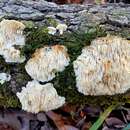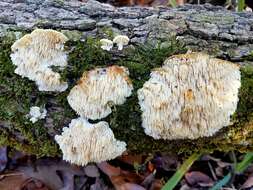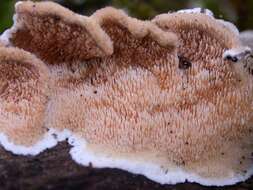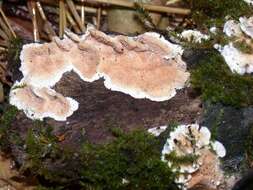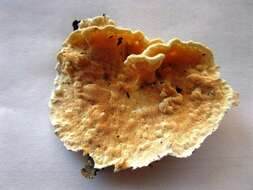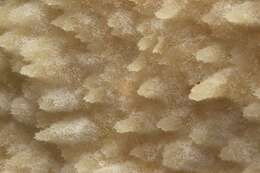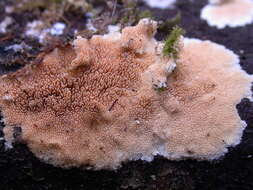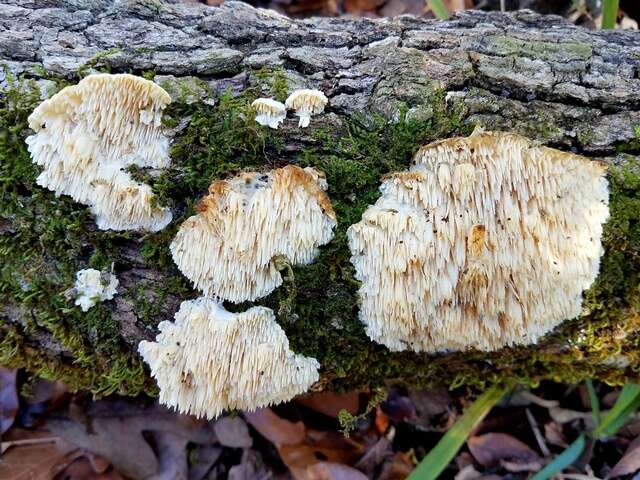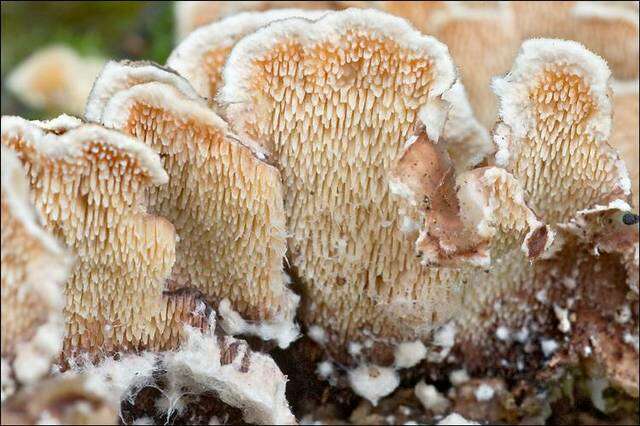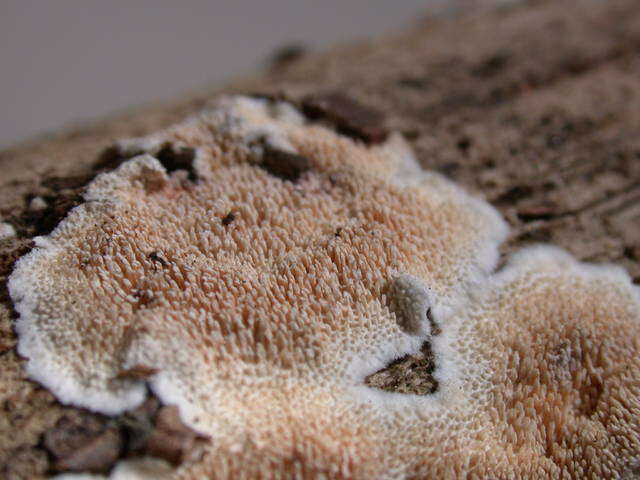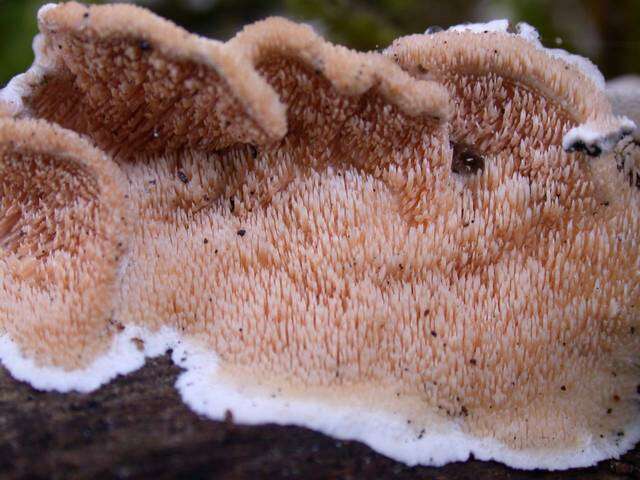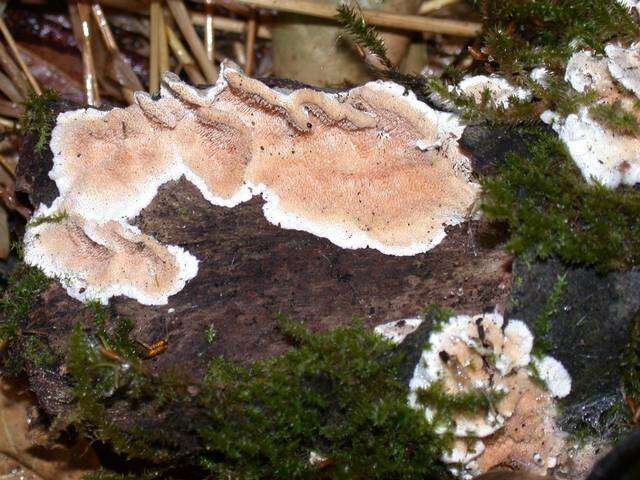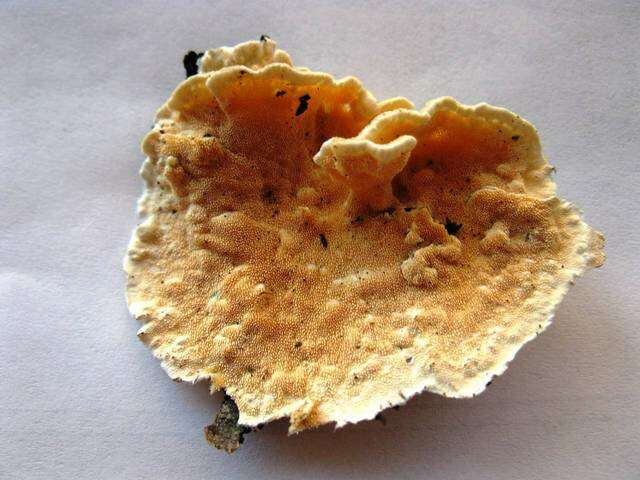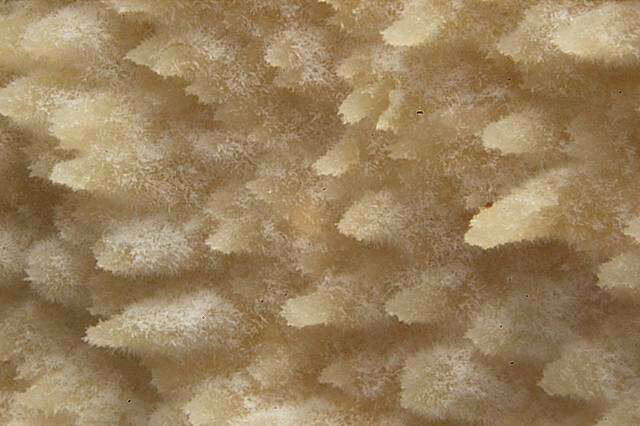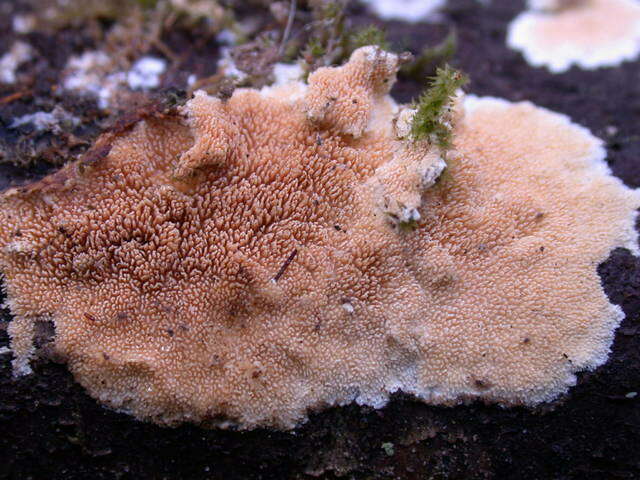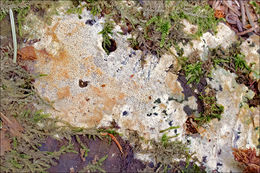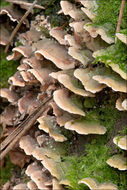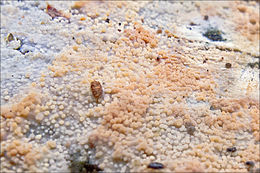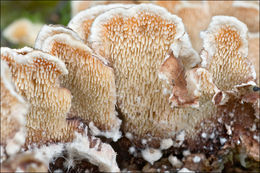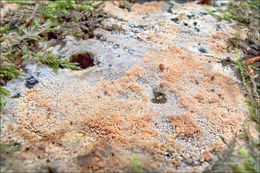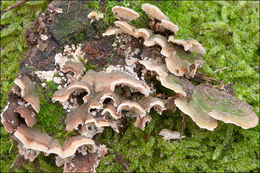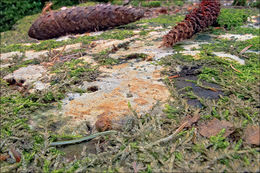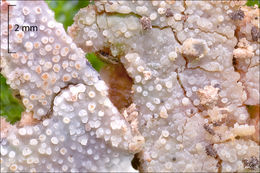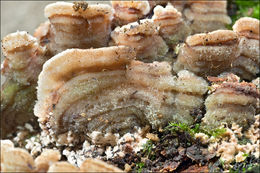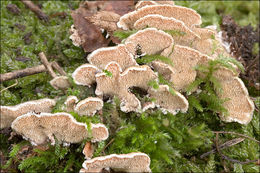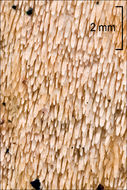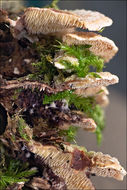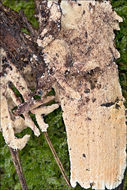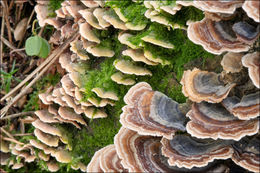-
Mushroom Observer Image 831337: Steccherinum oreophilum Lindsey & Gilb.
-
Mushroom Observer Image 199177: Steccherinum bourdotii Saliba & A. David
-
Mushroom Observer Image 1042: Steccherinum ochraceum (Pers.) Gray
-
Mushroom Observer Image 107568: Steccherinum ochraceum (Pers.) Gray
-
Mushroom Observer Image 107569: Steccherinum ochraceum (Pers.) Gray
-
Mushroom Observer Image 128963: Steccherinum ochraceum (Pers.) Gray
-
Mushroom Observer Image 300447: Steccherinum ochraceum (Pers.) Gray
-
Mushroom Observer Image 32680: Steccherinum ochraceum (Pers.) Gray
-
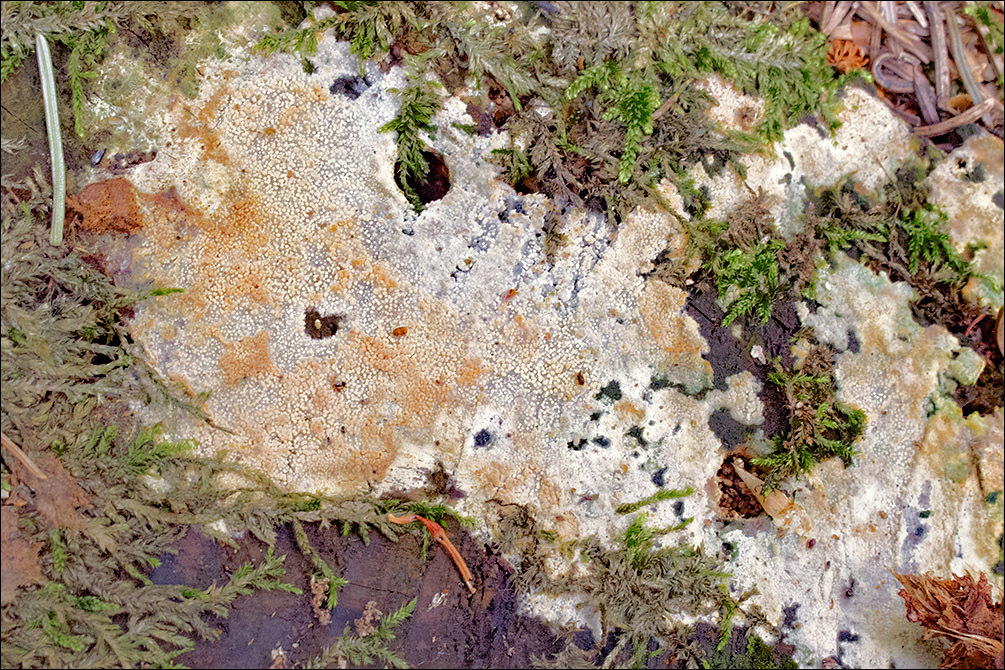
Slo.: vrsta bodika - Synonymy: Hydnum subcrinale Peck, Irpex subcrinalis (Peck) Saaren. & Kotir., Mycoleptodon kavinae Pilt, Bull. Odontia subcrinalis (Peck) Gilb., Steccherinum kavinae (Pilt) M.P. Christ. - Habitat: Old, mixed wood, Picea abies dominant; locally almost flat terrain, calcareous ground; in shade, fairly humid place; partly protected from direct rain by tree canopies; average precipitations 1.600-1.800 mm/year, average temperature 8-9 deg C, elevation 740 m (2.450 feet), Dinaric phytogeographical region.Substratum: on wood of a tree stump covered by mosses; in the final stage of disintegration; species undetermined but probably Picea abies or Abies alba. Place: North of Cerknica lake; SE of village Laze pri Gornjem jezeru; between hills marni gri, 768 m and Sovinek, 780 m, Notranjska, Slovenia EC. Comments: Steccherinum subcrinale is a loosely attached to its substratum, resupinate, effused teeth fungus. It can be distinguished from other Steccherinum species (in my region Steccherinum ochraceum and Steccherinum fimbriatum) by short, from (0.2)0.3 to 0.5(0.6) mm long cylindrical aculei (spines or teeth). Alternative species have pointed, conical (and mostly larger) 'spines'. The same seems true for similar species of genus Irpex. Steccherinum subcrinale also never forms shelf-like, small pilei but remains strictly resupinate.Steccherinum subcrinale is a rare species everywhere in Europe and denoted 'extremely rare' in Germany (Krieglsteiner 2000), Italy (Bernicchia 2010) and north Europe (Eriksson et al 1984). It is listed neither in Poler ed. 1998 nor in Ogris 2008 for Slovenia. Unfortunately, at the time I photographed this observation I was unaware what it might be and I didn't take samples to do microscopy and make exsiccate. Hence the determination remains uncertain although macroscopic traits from photos seem to fit quite good.Ref.: (1) G.J. Krieglsteiner (Hrsg.), Die Grosspilze Baden-Wrttembergs, Band 1, Ulmer (2000), p 332.(2) https://www.123pilze.de/DreamHC/Download/OckerResupinatStacheling.htm (accessed March 3. 2018) (3) L. Hagar, Ottova Encyklopedia Hb, Ottova Nakladatelstvi, Praha (2015) (in Slovakian), p 289.(4) A. Bernicchia, S.P. Gorjon, Cortitiaceaes .i., Fungi Europaei Vol.12., Edizioni Candusso (2010), p 631. (5) (x) A. Poler (ed.), Seznam gliv Slovenije (Checklist of Fungi of Slovenia), 2nd Ed., Assoc. of Mycol. Soc. of Slovenia (1998) (in Slovenian).(6) N. Ogris (ed.), Boletus Informaticus, Slovenian Forestry Institute, 2008 http://www.zdravgozd.si/bi_index.aspx (accessed March 3. 2018)(7) Eriksson, J.; Hjortstam, K.; Ryvarden, L., The Corticiaceae of North Europe. 7:1282-1449 1984) http://www.mycobank.org/BioloMICS.aspx?TableKey=14682616000000063&Rec=44436&Fields=All (accessed March 4. 2018)
-
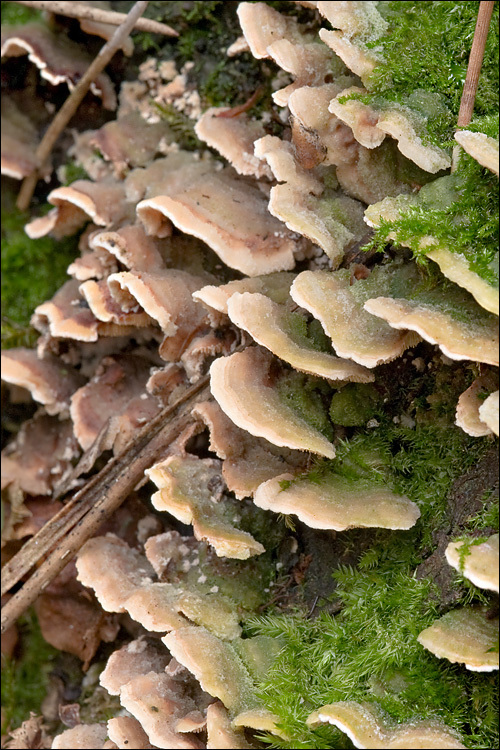
Habitat: At the side of a group of Pinus nigra trees, south oriented mountain slope, fairly sunny and relatively warm place, calcareous ground, partly protected from direct rain by tree canopies, average precipitations ~ 3.000 mm/year, average temperature 8-10 deg C, elevation 600 m (1.950 feet), alpine phytogeographical region. - Substratum: Dead stump of a cut down deciduous tree (possibly Ostrya carpinifolia) mostly still in bark and partly covered with mosses, also heavily infected with Trametes versicolor (as effuse-reflexed to pileate form), however fungus spread also to pieces of fallen off bark, herbaceous plant roots and old leaf petioles (as a resupinated form). - Comments: Subglobose to ovate and significantly larger spores (see spore measurement chart), smaller diameter pseudocystidia, conical and longer than 1 mm aculei (see Ref.:(2)) distinguish this observation from more frequent Steccherinum ochraceum well. All forms from pure resupinated to distinctly pileate present. Caps of pileate form zonate, up to 14 mm wide and 12 mm off the substrate, often confluent up to 2 mm thick, context thin, upper side beige-pink with some brown strips and green (algae?), with thin whitish margin. Hymenium aculei up to 1.5 mm long, mostly conical, ocher-pink (oac764); hymenium in resupinated form with white edge. Smell indistinctive on soil and rottenness. SP whitish. Spores smooth, subglobose to ovate, dimensions: 4.4 (SD = 0.3) x 3.7 (SD = 0.2) micr., Q = 1.21 (SD = 0.07), n = 30. Motic B2-211A, magnification 1.000 x, oil, in water. Pseudocystidia 5-7 micr. diameter. Measured spores and a comparison of spore dimensions of S. bourdotii and S. ochraceus. - S.bourdotii. Ref.: (1) G.J.Krieglsteiner (Hrsg.), Die Grosspilze Bade-Wrttembergs, Band 1, Ulmer (2000), p 327. (2) A.Bernicchia, S.P.Gorjon, Cortitiaceae s.i., Fungi Europaei Vol.12., Edizioni Candusso (2010), pp 624. (3) http://aphyllopower.blogspot.com/2008/06/steccherinum-bourdotii-rundsporiger.html - S.ochraceum. (1) G.J.Krieglsteiner (Hrsg.), Die Grosspilze Bade-Wrttembergs, Band 1, Ulmer (2000), p 327. (2) A.Bernicchia, S.P.Gorjon, Cortitiaceae s.i., Fungi Europaei Vol.12., Edizioni Candusso (2010), pp628. (3) J.Breitenbach, F.Kraenzlin, Eds., Fungi of Switzerland, Vol.1. Verlag Mykologia (1984).
-

Slo.: vrsta bodika - Synonymy: Hydnum subcrinale Peck, Irpex subcrinalis (Peck) Saaren. & Kotir., Mycoleptodon kavinae Pilt, Bull. Odontia subcrinalis (Peck) Gilb., Steccherinum kavinae (Pilt) M.P. Christ. - Habitat: Old, mixed wood, Picea abies dominant; locally almost flat terrain, calcareous ground; in shade, fairly humid place; partly protected from direct rain by tree canopies; average precipitations 1.600-1.800 mm/year, average temperature 8-9 deg C, elevation 740 m (2.450 feet), Dinaric phytogeographical region. Substratum: on wood of a tree stump covered by mosses; in the final stage of disintegration; species undetermined but probably Picea abies or Abies alba. Place: North of Cerknica lake; SE of village Laze pri Gornjem jezeru; between hills marni gri, 768 m and Sovinek, 780 m, Notranjska, Slovenia EC. Comments: Steccherinum subcrinale is a loosely attached to its substratum, resupinate, effused teeth fungus. It can be distinguished from other Steccherinum species (in my region Steccherinum ochraceum and Steccherinum fimbriatum) by short, from (0.2)0.3 to 0.5(0.6) mm long cylindrical aculei (spines or teeth). Alternative species have pointed, conical (and mostly larger) 'spines'. The same seems true for similar species of genus Irpex. Steccherinum subcrinale also never forms shelf-like, small pilei but remains strictly resupinate. Steccherinum subcrinale is a rare species everywhere in Europe and denoted 'extremely rare' in Germany (Krieglsteiner 2000), Italy (Bernicchia 2010) and north Europe (Eriksson et al 1984). It is listed neither in Poler ed. 1998 nor in Ogris 2008 for Slovenia. Unfortunately, at the time I photographed this observation I was unaware what it might be and I didn't take samples to do microscopy and make exsiccate. Hence the determination remains uncertain although macroscopic traits from photos seem to fit quite good. Ref.: (1) G.J. Krieglsteiner (Hrsg.), Die Grosspilze Baden-Wrttembergs, Band 1, Ulmer (2000), p 332. (2) https://www.123pilze.de/DreamHC/Download/OckerResupinatStacheling.htm (accessed March 3. 2018) (3) L. Hagar, Ottova Encyklopedia Hb, Ottova Nakladatelstvi, Praha (2015) (in Slovakian), p 289. (4) A. Bernicchia, S.P. Gorjon, Cortitiaceaes .i., Fungi Europaei Vol.12., Edizioni Candusso (2010), p 631. (5) (x) A. Poler (ed.), Seznam gliv Slovenije (Checklist of Fungi of Slovenia), 2nd Ed., Assoc. of Mycol. Soc. of Slovenia (1998) (in Slovenian). (6) N. Ogris (ed.), Boletus Informaticus, Slovenian Forestry Institute, 2008 http://www.zdravgozd.si/bi_index.aspx (accessed March 3. 2018) (7) Eriksson, J.; Hjortstam, K.; Ryvarden, L., The Corticiaceae of North Europe. 7:1282-1449 1984) http://www.mycobank.org/BioloMICS.aspx?TableKey=14682616000000063&Rec=44436&Fields=All (accessed March 4. 2018)
-

Habitat: At the side of a group of Pinus nigra trees, south oriented mountain slope, fairly sunny and relatively warm place, calcareous ground, partly protected from direct rain by tree canopies, average precipitations ~ 3.000 mm/year, average temperature 8-10 deg C, elevation 600 m (1.950 feet), alpine phytogeographical region. - Substratum: Dead stump of a cut down deciduous tree (possibly Ostrya carpinifolia) mostly still in bark and partly covered with mosses, also heavily infected with Trametes versicolor (as effuse-reflexed to pileate form), however fungus spread also to pieces of fallen off bark, herbaceous plant roots and old leaf petioles (as a resupinated form). - Comments: Subglobose to ovate and significantly larger spores (see spore measurement chart), smaller diameter pseudocystidia, conical and longer than 1 mm aculei (see Ref.:(2)) distinguish this observation from more frequent Steccherinum ochraceum well. All forms from pure resupinated to distinctly pileate present. Caps of pileate form zonate, up to 14 mm wide and 12 mm off the substrate, often confluent up to 2 mm thick, context thin, upper side beige-pink with some brown strips and green (algae?), with thin whitish margin. Hymenium aculei up to 1.5 mm long, mostly conical, ocher-pink (oac764); hymenium in resupinated form with white edge. Smell indistinctive on soil and rottenness. SP whitish. Spores smooth, subglobose to ovate, dimensions: 4.4 (SD = 0.3) x 3.7 (SD = 0.2) micr., Q = 1.21 (SD = 0.07), n = 30. Motic B2-211A, magnification 1.000 x, oil, in water. Pseudocystidia 5-7 micr. diameter. Measured spores and a comparison of spore dimensions of S. bourdotii and S. ochraceus. - S.bourdotii. Ref.: (1) G.J.Krieglsteiner (Hrsg.), Die Grosspilze Bade-Wrttembergs, Band 1, Ulmer (2000), p 327. (2) A.Bernicchia, S.P.Gorjon, Cortitiaceae s.i., Fungi Europaei Vol.12., Edizioni Candusso (2010), pp 624. (3) http://aphyllopower.blogspot.com/2008/06/steccherinum-bourdotii-rundsporiger.html - S.ochraceum. (1) G.J.Krieglsteiner (Hrsg.), Die Grosspilze Bade-Wrttembergs, Band 1, Ulmer (2000), p 327. (2) A.Bernicchia, S.P.Gorjon, Cortitiaceae s.i., Fungi Europaei Vol.12., Edizioni Candusso (2010), pp628. (3) J.Breitenbach, F.Kraenzlin, Eds., Fungi of Switzerland, Vol.1. Verlag Mykologia (1984).
-
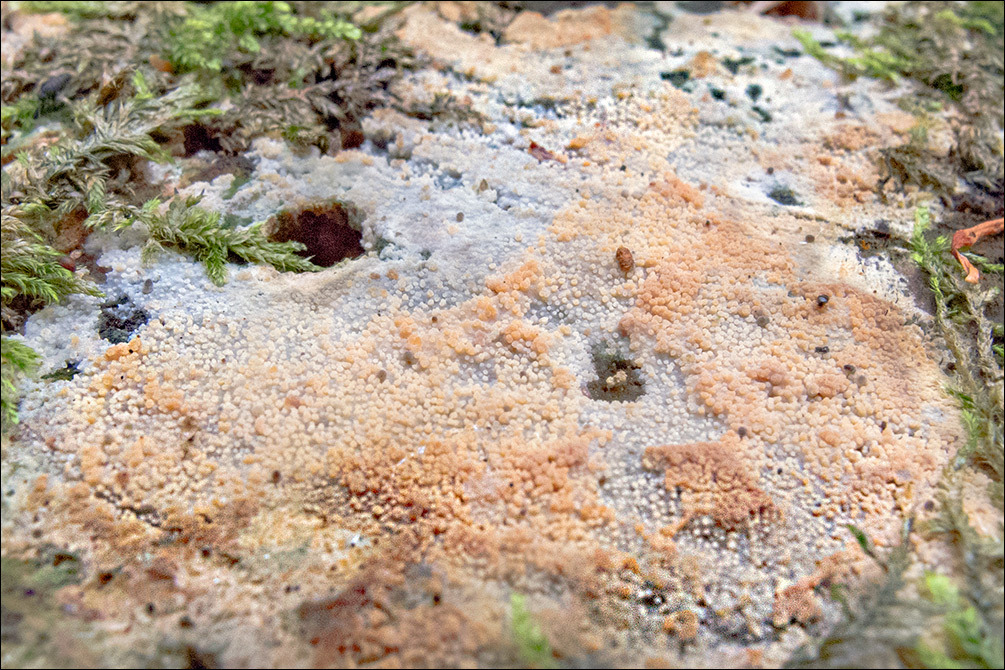
Slo.: vrsta bodika - Synonymy: Hydnum subcrinale Peck, Irpex subcrinalis (Peck) Saaren. & Kotir., Mycoleptodon kavinae Pilt, Bull. Odontia subcrinalis (Peck) Gilb., Steccherinum kavinae (Pilt) M.P. Christ. - Habitat: Old, mixed wood, Picea abies dominant; locally almost flat terrain, calcareous ground; in shade, fairly humid place; partly protected from direct rain by tree canopies; average precipitations 1.600-1.800 mm/year, average temperature 8-9 deg C, elevation 740 m (2.450 feet), Dinaric phytogeographical region. Substratum: on wood of a tree stump covered by mosses; in the final stage of disintegration; species undetermined but probably Picea abies or Abies alba. Place: North of Cerknica lake; SE of village Laze pri Gornjem jezeru; between hills marni gri, 768 m and Sovinek, 780 m, Notranjska, Slovenia EC. Comments: Steccherinum subcrinale is a loosely attached to its substratum, resupinate, effused teeth fungus. It can be distinguished from other Steccherinum species (in my region Steccherinum ochraceum and Steccherinum fimbriatum) by short, from (0.2)0.3 to 0.5(0.6) mm long cylindrical aculei (spines or teeth). Alternative species have pointed, conical (and mostly larger) 'spines'. The same seems true for similar species of genus Irpex. Steccherinum subcrinale also never forms shelf-like, small pilei but remains strictly resupinate. Steccherinum subcrinale is a rare species everywhere in Europe and denoted 'extremely rare' in Germany (Krieglsteiner 2000), Italy (Bernicchia 2010) and north Europe (Eriksson et al 1984). It is listed neither in Poler ed. 1998 nor in Ogris 2008 for Slovenia. Unfortunately, at the time I photographed this observation I was unaware what it might be and I didn't take samples to do microscopy and make exsiccate. Hence the determination remains uncertain although macroscopic traits from photos seem to fit quite good. Ref.: (1) G.J. Krieglsteiner (Hrsg.), Die Grosspilze Baden-Wrttembergs, Band 1, Ulmer (2000), p 332. (2) https://www.123pilze.de/DreamHC/Download/OckerResupinatStacheling.htm (accessed March 3. 2018) (3) L. Hagar, Ottova Encyklopedia Hb, Ottova Nakladatelstvi, Praha (2015) (in Slovakian), p 289. (4) A. Bernicchia, S.P. Gorjon, Cortitiaceaes .i., Fungi Europaei Vol.12., Edizioni Candusso (2010), p 631. (5) (x) A. Poler (ed.), Seznam gliv Slovenije (Checklist of Fungi of Slovenia), 2nd Ed., Assoc. of Mycol. Soc. of Slovenia (1998) (in Slovenian). (6) N. Ogris (ed.), Boletus Informaticus, Slovenian Forestry Institute, 2008 http://www.zdravgozd.si/bi_index.aspx (accessed March 3. 2018) (7) Eriksson, J.; Hjortstam, K.; Ryvarden, L., The Corticiaceae of North Europe. 7:1282-1449 1984) http://www.mycobank.org/BioloMICS.aspx?TableKey=14682616000000063&Rec=44436&Fields=All (accessed March 4. 2018)
-
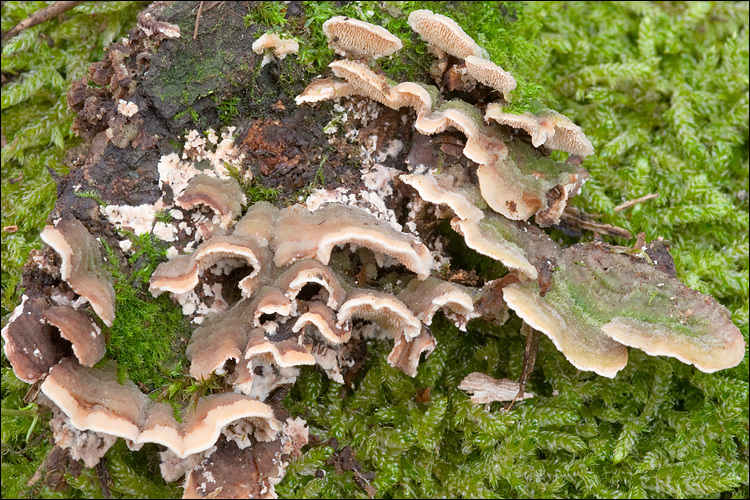
Habitat: At the side of a group of Pinus nigra trees, south oriented mountain slope, fairly sunny and relatively warm place, calcareous ground, partly protected from direct rain by tree canopies, average precipitations ~ 3.000 mm/year, average temperature 8-10 deg C, elevation 600 m (1.950 feet), alpine phytogeographical region. - Substratum: Dead stump of a cut down deciduous tree (possibly Ostrya carpinifolia) mostly still in bark and partly covered with mosses, also heavily infected with Trametes versicolor (as effuse-reflexed to pileate form), however fungus spread also to pieces of fallen off bark, herbaceous plant roots and old leaf petioles (as a resupinated form). - Comments: Subglobose to ovate and significantly larger spores (see spore measurement chart), smaller diameter pseudocystidia, conical and longer than 1 mm aculei (see Ref.:(2)) distinguish this observation from more frequent Steccherinum ochraceum well. All forms from pure resupinated to distinctly pileate present. Caps of pileate form zonate, up to 14 mm wide and 12 mm off the substrate, often confluent up to 2 mm thick, context thin, upper side beige-pink with some brown strips and green (algae?), with thin whitish margin. Hymenium aculei up to 1.5 mm long, mostly conical, ocher-pink (oac764); hymenium in resupinated form with white edge. Smell indistinctive on soil and rottenness. SP whitish. Spores smooth, subglobose to ovate, dimensions: 4.4 (SD = 0.3) x 3.7 (SD = 0.2) micr., Q = 1.21 (SD = 0.07), n = 30. Motic B2-211A, magnification 1.000 x, oil, in water. Pseudocystidia 5-7 micr. diameter. Measured spores and a comparison of spore dimensions of S. bourdotii and S. ochraceus. - S.bourdotii. Ref.: (1) G.J.Krieglsteiner (Hrsg.), Die Grosspilze Bade-Wrttembergs, Band 1, Ulmer (2000), p 327. (2) A.Bernicchia, S.P.Gorjon, Cortitiaceae s.i., Fungi Europaei Vol.12., Edizioni Candusso (2010), pp 624. (3) http://aphyllopower.blogspot.com/2008/06/steccherinum-bourdotii-rundsporiger.html - S.ochraceum. (1) G.J.Krieglsteiner (Hrsg.), Die Grosspilze Bade-Wrttembergs, Band 1, Ulmer (2000), p 327. (2) A.Bernicchia, S.P.Gorjon, Cortitiaceae s.i., Fungi Europaei Vol.12., Edizioni Candusso (2010), pp628. (3) J.Breitenbach, F.Kraenzlin, Eds., Fungi of Switzerland, Vol.1. Verlag Mykologia (1984).
-
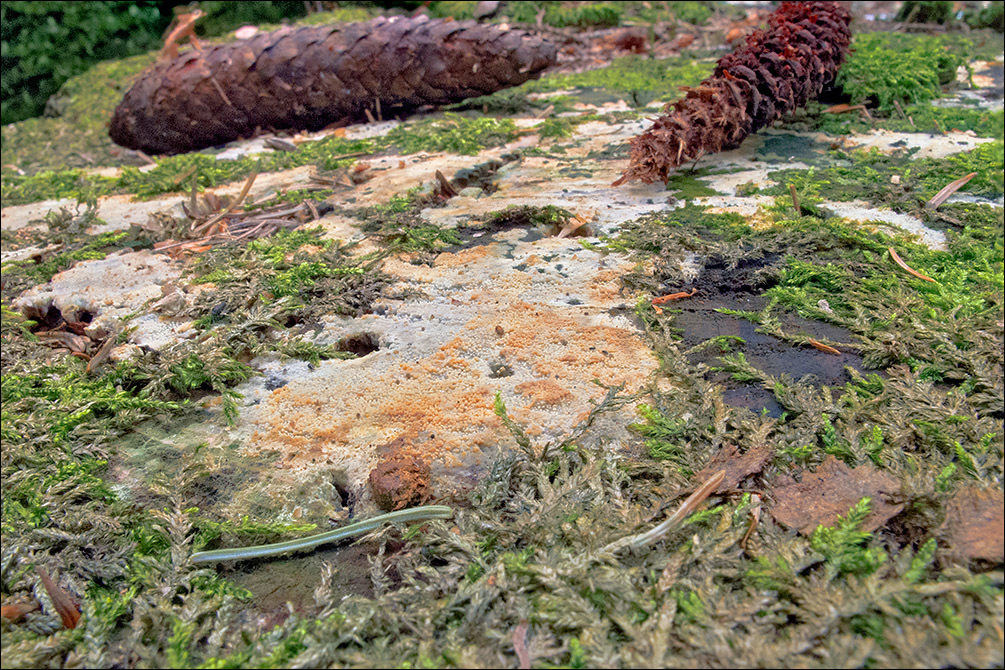
Slo.: vrsta bodika - Synonymy: Hydnum subcrinale Peck, Irpex subcrinalis (Peck) Saaren. & Kotir., Mycoleptodon kavinae Pilt, Bull. Odontia subcrinalis (Peck) Gilb., Steccherinum kavinae (Pilt) M.P. Christ. - Habitat: Old, mixed wood, Picea abies dominant; locally almost flat terrain, calcareous ground; in shade, fairly humid place; partly protected from direct rain by tree canopies; average precipitations 1.600-1.800 mm/year, average temperature 8-9 deg C, elevation 740 m (2.450 feet), Dinaric phytogeographical region. Substratum: on wood of a tree stump covered by mosses; in the final stage of disintegration; species undetermined but probably Picea abies or Abies alba. Place: North of Cerknica lake; SE of village Laze pri Gornjem jezeru; between hills marni gri, 768 m and Sovinek, 780 m, Notranjska, Slovenia EC. Comments: Steccherinum subcrinale is a loosely attached to its substratum, resupinate, effused teeth fungus. It can be distinguished from other Steccherinum species (in my region Steccherinum ochraceum and Steccherinum fimbriatum) by short, from (0.2)0.3 to 0.5(0.6) mm long cylindrical aculei (spines or teeth). Alternative species have pointed, conical (and mostly larger) 'spines'. The same seems true for similar species of genus Irpex. Steccherinum subcrinale also never forms shelf-like, small pilei but remains strictly resupinate. Steccherinum subcrinale is a rare species everywhere in Europe and denoted 'extremely rare' in Germany (Krieglsteiner 2000), Italy (Bernicchia 2010) and north Europe (Eriksson et al 1984). It is listed neither in Poler ed. 1998 nor in Ogris 2008 for Slovenia. Unfortunately, at the time I photographed this observation I was unaware what it might be and I didn't take samples to do microscopy and make exsiccate. Hence the determination remains uncertain although macroscopic traits from photos seem to fit quite good. Ref.: (1) G.J. Krieglsteiner (Hrsg.), Die Grosspilze Baden-Wrttembergs, Band 1, Ulmer (2000), p 332. (2) https://www.123pilze.de/DreamHC/Download/OckerResupinatStacheling.htm (accessed March 3. 2018) (3) L. Hagar, Ottova Encyklopedia Hb, Ottova Nakladatelstvi, Praha (2015) (in Slovakian), p 289. (4) A. Bernicchia, S.P. Gorjon, Cortitiaceaes .i., Fungi Europaei Vol.12., Edizioni Candusso (2010), p 631. (5) (x) A. Poler (ed.), Seznam gliv Slovenije (Checklist of Fungi of Slovenia), 2nd Ed., Assoc. of Mycol. Soc. of Slovenia (1998) (in Slovenian). (6) N. Ogris (ed.), Boletus Informaticus, Slovenian Forestry Institute, 2008 http://www.zdravgozd.si/bi_index.aspx (accessed March 3. 2018) (7) Eriksson, J.; Hjortstam, K.; Ryvarden, L., The Corticiaceae of North Europe. 7:1282-1449 1984) http://www.mycobank.org/BioloMICS.aspx?TableKey=14682616000000063&Rec=44436&Fields=All (accessed March 4. 2018)
-
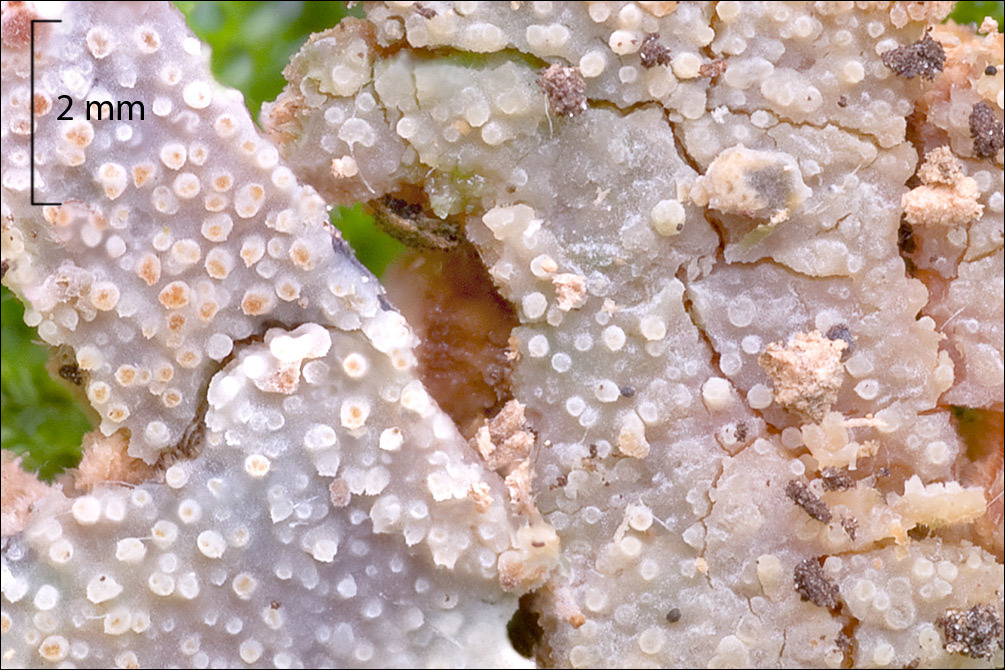
Slo.: vrsta bodika - Synonymy: Hydnum subcrinale Peck, Irpex subcrinalis (Peck) Saaren. & Kotir., Mycoleptodon kavinae Pilt, Bull. Odontia subcrinalis (Peck) Gilb., Steccherinum kavinae (Pilt) M.P. Christ. - Habitat: Old, mixed wood, Picea abies dominant; locally almost flat terrain, calcareous ground; in shade, fairly humid place; partly protected from direct rain by tree canopies; average precipitations 1.600-1.800 mm/year, average temperature 8-9 deg C, elevation 740 m (2.450 feet), Dinaric phytogeographical region. Substratum: on wood of a tree stump covered by mosses; in the final stage of disintegration; species undetermined but probably Picea abies or Abies alba. Place: North of Cerknica lake; SE of village Laze pri Gornjem jezeru; between hills marni gri, 768 m and Sovinek, 780 m, Notranjska, Slovenia EC. Comments: Steccherinum subcrinale is a loosely attached to its substratum, resupinate, effused teeth fungus. It can be distinguished from other Steccherinum species (in my region Steccherinum ochraceum and Steccherinum fimbriatum) by short, from (0.2)0.3 to 0.5(0.6) mm long cylindrical aculei (spines or teeth). Alternative species have pointed, conical (and mostly larger) 'spines'. The same seems true for similar species of genus Irpex. Steccherinum subcrinale also never forms shelf-like, small pilei but remains strictly resupinate. Steccherinum subcrinale is a rare species everywhere in Europe and denoted 'extremely rare' in Germany (Krieglsteiner 2000), Italy (Bernicchia 2010) and north Europe (Eriksson et al 1984). It is listed neither in Poler ed. 1998 nor in Ogris 2008 for Slovenia. Unfortunately, at the time I photographed this observation I was unaware what it might be and I didn't take samples to do microscopy and make exsiccate. Hence the determination remains uncertain although macroscopic traits from photos seem to fit quite good. Ref.: (1) G.J. Krieglsteiner (Hrsg.), Die Grosspilze Baden-Wrttembergs, Band 1, Ulmer (2000), p 332. (2) https://www.123pilze.de/DreamHC/Download/OckerResupinatStacheling.htm (accessed March 3. 2018) (3) L. Hagar, Ottova Encyklopedia Hb, Ottova Nakladatelstvi, Praha (2015) (in Slovakian), p 289. (4) A. Bernicchia, S.P. Gorjon, Cortitiaceaes .i., Fungi Europaei Vol.12., Edizioni Candusso (2010), p 631. (5) (x) A. Poler (ed.), Seznam gliv Slovenije (Checklist of Fungi of Slovenia), 2nd Ed., Assoc. of Mycol. Soc. of Slovenia (1998) (in Slovenian). (6) N. Ogris (ed.), Boletus Informaticus, Slovenian Forestry Institute, 2008 http://www.zdravgozd.si/bi_index.aspx (accessed March 3. 2018) (7) Eriksson, J.; Hjortstam, K.; Ryvarden, L., The Corticiaceae of North Europe. 7:1282-1449 1984) http://www.mycobank.org/BioloMICS.aspx?TableKey=14682616000000063&Rec=44436&Fields=All (accessed March 4. 2018)
-
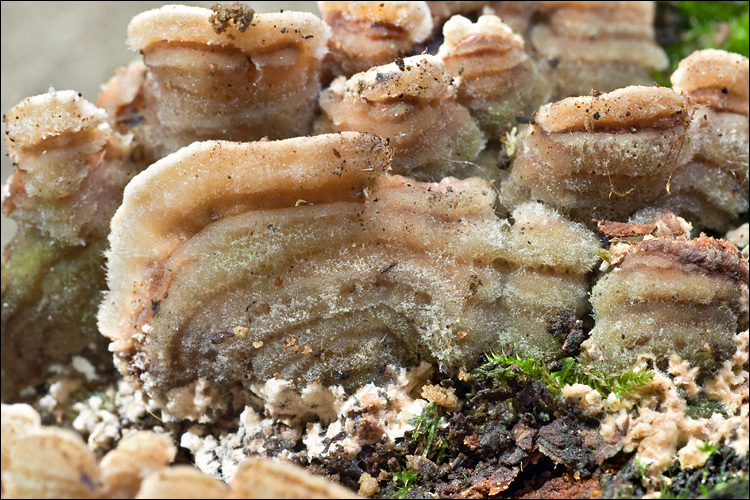
Habitat: At the side of a group of Pinus nigra trees, south oriented mountain slope, fairly sunny and relatively warm place, calcareous ground, partly protected from direct rain by tree canopies, average precipitations ~ 3.000 mm/year, average temperature 8-10 deg C, elevation 600 m (1.950 feet), alpine phytogeographical region. - Substratum: Dead stump of a cut down deciduous tree (possibly Ostrya carpinifolia) mostly still in bark and partly covered with mosses, also heavily infected with Trametes versicolor (as effuse-reflexed to pileate form), however fungus spread also to pieces of fallen off bark, herbaceous plant roots and old leaf petioles (as a resupinated form). - Comments: Subglobose to ovate and significantly larger spores (see spore measurement chart), smaller diameter pseudocystidia, conical and longer than 1 mm aculei (see Ref.:(2)) distinguish this observation from more frequent Steccherinum ochraceum well. All forms from pure resupinated to distinctly pileate present. Caps of pileate form zonate, up to 14 mm wide and 12 mm off the substrate, often confluent up to 2 mm thick, context thin, upper side beige-pink with some brown strips and green (algae?), with thin whitish margin. Hymenium aculei up to 1.5 mm long, mostly conical, ocher-pink (oac764); hymenium in resupinated form with white edge. Smell indistinctive on soil and rottenness. SP whitish. Spores smooth, subglobose to ovate, dimensions: 4.4 (SD = 0.3) x 3.7 (SD = 0.2) micr., Q = 1.21 (SD = 0.07), n = 30. Motic B2-211A, magnification 1.000 x, oil, in water. Pseudocystidia 5-7 micr. diameter. Measured spores and a comparison of spore dimensions of S. bourdotii and S. ochraceus. - S.bourdotii. Ref.: (1) G.J.Krieglsteiner (Hrsg.), Die Grosspilze Bade-Wrttembergs, Band 1, Ulmer (2000), p 327. (2) A.Bernicchia, S.P.Gorjon, Cortitiaceae s.i., Fungi Europaei Vol.12., Edizioni Candusso (2010), pp 624. (3) http://aphyllopower.blogspot.com/2008/06/steccherinum-bourdotii-rundsporiger.html - S.ochraceum. (1) G.J.Krieglsteiner (Hrsg.), Die Grosspilze Bade-Wrttembergs, Band 1, Ulmer (2000), p 327. (2) A.Bernicchia, S.P.Gorjon, Cortitiaceae s.i., Fungi Europaei Vol.12., Edizioni Candusso (2010), pp628. (3) J.Breitenbach, F.Kraenzlin, Eds., Fungi of Switzerland, Vol.1. Verlag Mykologia (1984).
-
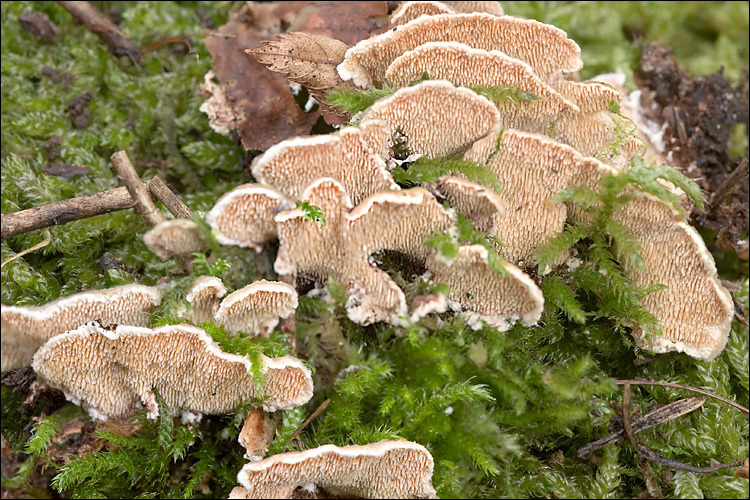
Habitat: At the side of a group of Pinus nigra trees, south oriented mountain slope, fairly sunny and relatively warm place, calcareous ground, partly protected from direct rain by tree canopies, average precipitations ~ 3.000 mm/year, average temperature 8-10 deg C, elevation 600 m (1.950 feet), alpine phytogeographical region. - Substratum: Dead stump of a cut down deciduous tree (possibly Ostrya carpinifolia) mostly still in bark and partly covered with mosses, also heavily infected with Trametes versicolor (as effuse-reflexed to pileate form), however fungus spread also to pieces of fallen off bark, herbaceous plant roots and old leaf petioles (as a resupinated form). - Comments: Subglobose to ovate and significantly larger spores (see spore measurement chart), smaller diameter pseudocystidia, conical and longer than 1 mm aculei (see Ref.:(2)) distinguish this observation from more frequent Steccherinum ochraceum well. All forms from pure resupinated to distinctly pileate present. Caps of pileate form zonate, up to 14 mm wide and 12 mm off the substrate, often confluent up to 2 mm thick, context thin, upper side beige-pink with some brown strips and green (algae?), with thin whitish margin. Hymenium aculei up to 1.5 mm long, mostly conical, ocher-pink (oac764); hymenium in resupinated form with white edge. Smell indistinctive on soil and rottenness. SP whitish. Spores smooth, subglobose to ovate, dimensions: 4.4 (SD = 0.3) x 3.7 (SD = 0.2) micr., Q = 1.21 (SD = 0.07), n = 30. Motic B2-211A, magnification 1.000 x, oil, in water. Pseudocystidia 5-7 micr. diameter. Measured spores and a comparison of spore dimensions of S. bourdotii and S. ochraceus. - S.bourdotii. Ref.: (1) G.J.Krieglsteiner (Hrsg.), Die Grosspilze Bade-Wrttembergs, Band 1, Ulmer (2000), p 327. (2) A.Bernicchia, S.P.Gorjon, Cortitiaceae s.i., Fungi Europaei Vol.12., Edizioni Candusso (2010), pp 624. (3) http://aphyllopower.blogspot.com/2008/06/steccherinum-bourdotii-rundsporiger.html - S.ochraceum. (1) G.J.Krieglsteiner (Hrsg.), Die Grosspilze Bade-Wrttembergs, Band 1, Ulmer (2000), p 327. (2) A.Bernicchia, S.P.Gorjon, Cortitiaceae s.i., Fungi Europaei Vol.12., Edizioni Candusso (2010), pp628. (3) J.Breitenbach, F.Kraenzlin, Eds., Fungi of Switzerland, Vol.1. Verlag Mykologia (1984).
-
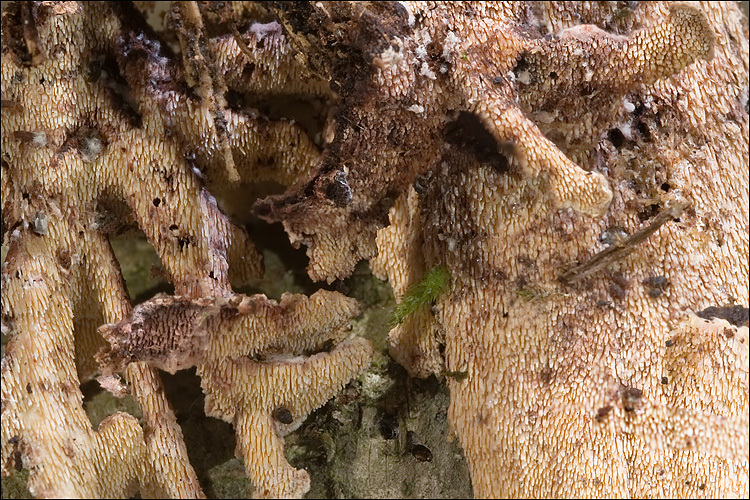
Habitat: At the side of a group of Pinus nigra trees, south oriented mountain slope, fairly sunny and relatively warm place, calcareous ground, partly protected from direct rain by tree canopies, average precipitations ~ 3.000 mm/year, average temperature 8-10 deg C, elevation 600 m (1.950 feet), alpine phytogeographical region. - Substratum: Dead stump of a cut down deciduous tree (possibly Ostrya carpinifolia) mostly still in bark and partly covered with mosses, also heavily infected with Trametes versicolor (as effuse-reflexed to pileate form), however fungus spread also to pieces of fallen off bark, herbaceous plant roots and old leaf petioles (as a resupinated form). - Comments: Subglobose to ovate and significantly larger spores (see spore measurement chart), smaller diameter pseudocystidia, conical and longer than 1 mm aculei (see Ref.:(2)) distinguish this observation from more frequent Steccherinum ochraceum well. All forms from pure resupinated to distinctly pileate present. Caps of pileate form zonate, up to 14 mm wide and 12 mm off the substrate, often confluent up to 2 mm thick, context thin, upper side beige-pink with some brown strips and green (algae?), with thin whitish margin. Hymenium aculei up to 1.5 mm long, mostly conical, ocher-pink (oac764); hymenium in resupinated form with white edge. Smell indistinctive on soil and rottenness. SP whitish. Spores smooth, subglobose to ovate, dimensions: 4.4 (SD = 0.3) x 3.7 (SD = 0.2) micr., Q = 1.21 (SD = 0.07), n = 30. Motic B2-211A, magnification 1.000 x, oil, in water. Pseudocystidia 5-7 micr. diameter. Measured spores and a comparison of spore dimensions of S. bourdotii and S. ochraceus. - S.bourdotii. Ref.: (1) G.J.Krieglsteiner (Hrsg.), Die Grosspilze Bade-Wrttembergs, Band 1, Ulmer (2000), p 327. (2) A.Bernicchia, S.P.Gorjon, Cortitiaceae s.i., Fungi Europaei Vol.12., Edizioni Candusso (2010), pp 624. (3) http://aphyllopower.blogspot.com/2008/06/steccherinum-bourdotii-rundsporiger.html - S.ochraceum. (1) G.J.Krieglsteiner (Hrsg.), Die Grosspilze Bade-Wrttembergs, Band 1, Ulmer (2000), p 327. (2) A.Bernicchia, S.P.Gorjon, Cortitiaceae s.i., Fungi Europaei Vol.12., Edizioni Candusso (2010), pp628. (3) J.Breitenbach, F.Kraenzlin, Eds., Fungi of Switzerland, Vol.1. Verlag Mykologia (1984).
-

Habitat: At the side of a group of Pinus nigra trees, south oriented mountain slope, fairly sunny and relatively warm place, calcareous ground, partly protected from direct rain by tree canopies, average precipitations ~ 3.000 mm/year, average temperature 8-10 deg C, elevation 600 m (1.950 feet), alpine phytogeographical region. - Substratum: Dead stump of a cut down deciduous tree (possibly Ostrya carpinifolia) mostly still in bark and partly covered with mosses, also heavily infected with Trametes versicolor (as effuse-reflexed to pileate form), however fungus spread also to pieces of fallen off bark, herbaceous plant roots and old leaf petioles (as a resupinated form). - Comments: Subglobose to ovate and significantly larger spores (see spore measurement chart), smaller diameter pseudocystidia, conical and longer than 1 mm aculei (see Ref.:(2)) distinguish this observation from more frequent Steccherinum ochraceum well. All forms from pure resupinated to distinctly pileate present. Caps of pileate form zonate, up to 14 mm wide and 12 mm off the substrate, often confluent up to 2 mm thick, context thin, upper side beige-pink with some brown strips and green (algae?), with thin whitish margin. Hymenium aculei up to 1.5 mm long, mostly conical, ocher-pink (oac764); hymenium in resupinated form with white edge. Smell indistinctive on soil and rottenness. SP whitish. Spores smooth, subglobose to ovate, dimensions: 4.4 (SD = 0.3) x 3.7 (SD = 0.2) micr., Q = 1.21 (SD = 0.07), n = 30. Motic B2-211A, magnification 1.000 x, oil, in water. Pseudocystidia 5-7 micr. diameter. Measured spores and a comparison of spore dimensions of S. bourdotii and S. ochraceus. - S.bourdotii. Ref.: (1) G.J.Krieglsteiner (Hrsg.), Die Grosspilze Bade-Wrttembergs, Band 1, Ulmer (2000), p 327. (2) A.Bernicchia, S.P.Gorjon, Cortitiaceae s.i., Fungi Europaei Vol.12., Edizioni Candusso (2010), pp 624. (3) http://aphyllopower.blogspot.com/2008/06/steccherinum-bourdotii-rundsporiger.html - S.ochraceum. (1) G.J.Krieglsteiner (Hrsg.), Die Grosspilze Bade-Wrttembergs, Band 1, Ulmer (2000), p 327. (2) A.Bernicchia, S.P.Gorjon, Cortitiaceae s.i., Fungi Europaei Vol.12., Edizioni Candusso (2010), pp628. (3) J.Breitenbach, F.Kraenzlin, Eds., Fungi of Switzerland, Vol.1. Verlag Mykologia (1984).
-
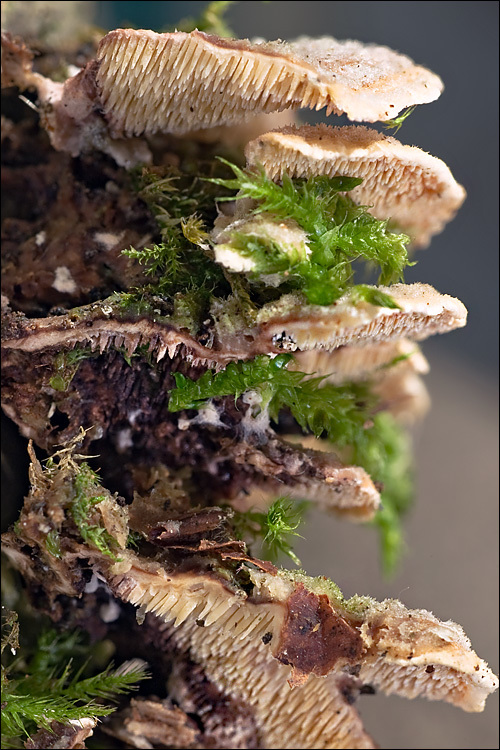
Habitat: At the side of a group of Pinus nigra trees, south oriented mountain slope, fairly sunny and relatively warm place, calcareous ground, partly protected from direct rain by tree canopies, average precipitations ~ 3.000 mm/year, average temperature 8-10 deg C, elevation 600 m (1.950 feet), alpine phytogeographical region. - Substratum: Dead stump of a cut down deciduous tree (possibly Ostrya carpinifolia) mostly still in bark and partly covered with mosses, also heavily infected with Trametes versicolor (as effuse-reflexed to pileate form), however fungus spread also to pieces of fallen off bark, herbaceous plant roots and old leaf petioles (as a resupinated form). - Comments: Subglobose to ovate and significantly larger spores (see spore measurement chart), smaller diameter pseudocystidia, conical and longer than 1 mm aculei (see Ref.:(2)) distinguish this observation from more frequent Steccherinum ochraceum well. All forms from pure resupinated to distinctly pileate present. Caps of pileate form zonate, up to 14 mm wide and 12 mm off the substrate, often confluent up to 2 mm thick, context thin, upper side beige-pink with some brown strips and green (algae?), with thin whitish margin. Hymenium aculei up to 1.5 mm long, mostly conical, ocher-pink (oac764); hymenium in resupinated form with white edge. Smell indistinctive on soil and rottenness. SP whitish. Spores smooth, subglobose to ovate, dimensions: 4.4 (SD = 0.3) x 3.7 (SD = 0.2) micr., Q = 1.21 (SD = 0.07), n = 30. Motic B2-211A, magnification 1.000 x, oil, in water. Pseudocystidia 5-7 micr. diameter. Measured spores and a comparison of spore dimensions of S. bourdotii and S. ochraceus. - S.bourdotii. Ref.: (1) G.J.Krieglsteiner (Hrsg.), Die Grosspilze Bade-Wrttembergs, Band 1, Ulmer (2000), p 327. (2) A.Bernicchia, S.P.Gorjon, Cortitiaceae s.i., Fungi Europaei Vol.12., Edizioni Candusso (2010), pp 624. (3) http://aphyllopower.blogspot.com/2008/06/steccherinum-bourdotii-rundsporiger.html - S.ochraceum. (1) G.J.Krieglsteiner (Hrsg.), Die Grosspilze Bade-Wrttembergs, Band 1, Ulmer (2000), p 327. (2) A.Bernicchia, S.P.Gorjon, Cortitiaceae s.i., Fungi Europaei Vol.12., Edizioni Candusso (2010), pp628. (3) J.Breitenbach, F.Kraenzlin, Eds., Fungi of Switzerland, Vol.1. Verlag Mykologia (1984).
-
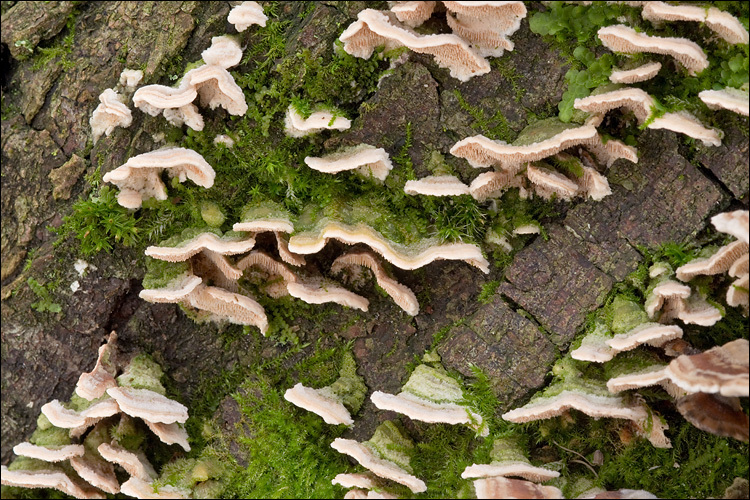
Habitat: At the side of a group of Pinus nigra trees, south oriented mountain slope, fairly sunny and relatively warm place, calcareous ground, partly protected from direct rain by tree canopies, average precipitations ~ 3.000 mm/year, average temperature 8-10 deg C, elevation 600 m (1.950 feet), alpine phytogeographical region. - Substratum: Dead stump of a cut down deciduous tree (possibly Ostrya carpinifolia) mostly still in bark and partly covered with mosses, also heavily infected with Trametes versicolor (as effuse-reflexed to pileate form), however fungus spread also to pieces of fallen off bark, herbaceous plant roots and old leaf petioles (as a resupinated form). - Comments: Subglobose to ovate and significantly larger spores (see spore measurement chart), smaller diameter pseudocystidia, conical and longer than 1 mm aculei (see Ref.:(2)) distinguish this observation from more frequent Steccherinum ochraceum well. All forms from pure resupinated to distinctly pileate present. Caps of pileate form zonate, up to 14 mm wide and 12 mm off the substrate, often confluent up to 2 mm thick, context thin, upper side beige-pink with some brown strips and green (algae?), with thin whitish margin. Hymenium aculei up to 1.5 mm long, mostly conical, ocher-pink (oac764); hymenium in resupinated form with white edge. Smell indistinctive on soil and rottenness. SP whitish. Spores smooth, subglobose to ovate, dimensions: 4.4 (SD = 0.3) x 3.7 (SD = 0.2) micr., Q = 1.21 (SD = 0.07), n = 30. Motic B2-211A, magnification 1.000 x, oil, in water. Pseudocystidia 5-7 micr. diameter. Measured spores and a comparison of spore dimensions of S. bourdotii and S. ochraceus. - S.bourdotii. Ref.: (1) G.J.Krieglsteiner (Hrsg.), Die Grosspilze Bade-Wrttembergs, Band 1, Ulmer (2000), p 327. (2) A.Bernicchia, S.P.Gorjon, Cortitiaceae s.i., Fungi Europaei Vol.12., Edizioni Candusso (2010), pp 624. (3) http://aphyllopower.blogspot.com/2008/06/steccherinum-bourdotii-rundsporiger.html - S.ochraceum. (1) G.J.Krieglsteiner (Hrsg.), Die Grosspilze Bade-Wrttembergs, Band 1, Ulmer (2000), p 327. (2) A.Bernicchia, S.P.Gorjon, Cortitiaceae s.i., Fungi Europaei Vol.12., Edizioni Candusso (2010), pp628. (3) J.Breitenbach, F.Kraenzlin, Eds., Fungi of Switzerland, Vol.1. Verlag Mykologia (1984).
-
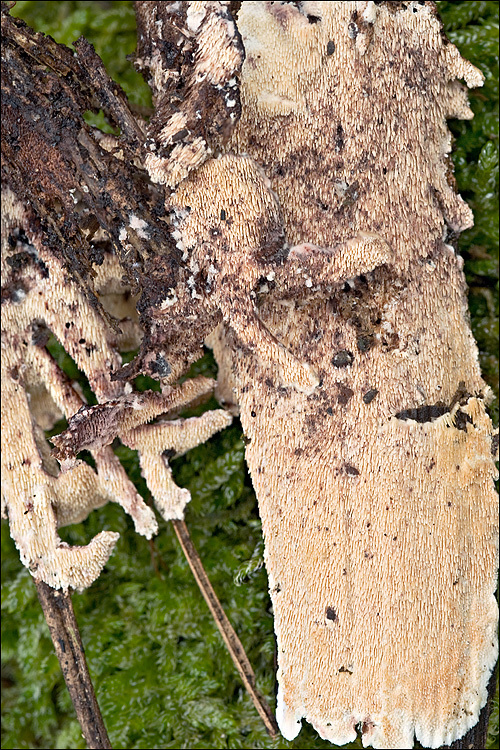
Habitat: At the side of a group of Pinus nigra trees, south oriented mountain slope, fairly sunny and relatively warm place, calcareous ground, partly protected from direct rain by tree canopies, average precipitations ~ 3.000 mm/year, average temperature 8-10 deg C, elevation 600 m (1.950 feet), alpine phytogeographical region. - Substratum: Dead stump of a cut down deciduous tree (possibly Ostrya carpinifolia) mostly still in bark and partly covered with mosses, also heavily infected with Trametes versicolor (as effuse-reflexed to pileate form), however fungus spread also to pieces of fallen off bark, herbaceous plant roots and old leaf petioles (as a resupinated form). - Comments: Subglobose to ovate and significantly larger spores (see spore measurement chart), smaller diameter pseudocystidia, conical and longer than 1 mm aculei (see Ref.:(2)) distinguish this observation from more frequent Steccherinum ochraceum well. All forms from pure resupinated to distinctly pileate present. Caps of pileate form zonate, up to 14 mm wide and 12 mm off the substrate, often confluent up to 2 mm thick, context thin, upper side beige-pink with some brown strips and green (algae?), with thin whitish margin. Hymenium aculei up to 1.5 mm long, mostly conical, ocher-pink (oac764); hymenium in resupinated form with white edge. Smell indistinctive on soil and rottenness. SP whitish. Spores smooth, subglobose to ovate, dimensions: 4.4 (SD = 0.3) x 3.7 (SD = 0.2) micr., Q = 1.21 (SD = 0.07), n = 30. Motic B2-211A, magnification 1.000 x, oil, in water. Pseudocystidia 5-7 micr. diameter. Measured spores and a comparison of spore dimensions of S. bourdotii and S. ochraceus. - S.bourdotii. Ref.: (1) G.J.Krieglsteiner (Hrsg.), Die Grosspilze Bade-Wrttembergs, Band 1, Ulmer (2000), p 327. (2) A.Bernicchia, S.P.Gorjon, Cortitiaceae s.i., Fungi Europaei Vol.12., Edizioni Candusso (2010), pp 624. (3) http://aphyllopower.blogspot.com/2008/06/steccherinum-bourdotii-rundsporiger.html - S.ochraceum. (1) G.J.Krieglsteiner (Hrsg.), Die Grosspilze Bade-Wrttembergs, Band 1, Ulmer (2000), p 327. (2) A.Bernicchia, S.P.Gorjon, Cortitiaceae s.i., Fungi Europaei Vol.12., Edizioni Candusso (2010), pp628. (3) J.Breitenbach, F.Kraenzlin, Eds., Fungi of Switzerland, Vol.1. Verlag Mykologia (1984).
-

Habitat: At the side of a group of Pinus nigra trees, south oriented mountain slope, fairly sunny and relatively warm place, calcareous ground, partly protected from direct rain by tree canopies, average precipitations ~ 3.000 mm/year, average temperature 8-10 deg C, elevation 600 m (1.950 feet), alpine phytogeographical region. - Substratum: Dead stump of a cut down deciduous tree (possibly Ostrya carpinifolia) mostly still in bark and partly covered with mosses, also heavily infected with Trametes versicolor (as effuse-reflexed to pileate form), however fungus spread also to pieces of fallen off bark, herbaceous plant roots and old leaf petioles (as a resupinated form). - Comments: Subglobose to ovate and significantly larger spores (see spore measurement chart), smaller diameter pseudocystidia, conical and longer than 1 mm aculei (see Ref.:(2)) distinguish this observation from more frequent Steccherinum ochraceum well. All forms from pure resupinated to distinctly pileate present. Caps of pileate form zonate, up to 14 mm wide and 12 mm off the substrate, often confluent up to 2 mm thick, context thin, upper side beige-pink with some brown strips and green (algae?), with thin whitish margin. Hymenium aculei up to 1.5 mm long, mostly conical, ocher-pink (oac764); hymenium in resupinated form with white edge. Smell indistinctive on soil and rottenness. SP whitish. Spores smooth, subglobose to ovate, dimensions: 4.4 (SD = 0.3) x 3.7 (SD = 0.2) micr., Q = 1.21 (SD = 0.07), n = 30. Motic B2-211A, magnification 1.000 x, oil, in water. Pseudocystidia 5-7 micr. diameter. Measured spores and a comparison of spore dimensions of S. bourdotii and S. ochraceus. - S.bourdotii. Ref.: (1) G.J.Krieglsteiner (Hrsg.), Die Grosspilze Bade-Wrttembergs, Band 1, Ulmer (2000), p 327. (2) A.Bernicchia, S.P.Gorjon, Cortitiaceae s.i., Fungi Europaei Vol.12., Edizioni Candusso (2010), pp 624. (3) http://aphyllopower.blogspot.com/2008/06/steccherinum-bourdotii-rundsporiger.html - S.ochraceum. (1) G.J.Krieglsteiner (Hrsg.), Die Grosspilze Bade-Wrttembergs, Band 1, Ulmer (2000), p 327. (2) A.Bernicchia, S.P.Gorjon, Cortitiaceae s.i., Fungi Europaei Vol.12., Edizioni Candusso (2010), pp628. (3) J.Breitenbach, F.Kraenzlin, Eds., Fungi of Switzerland, Vol.1. Verlag Mykologia (1984).

